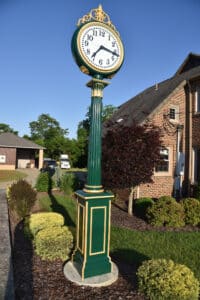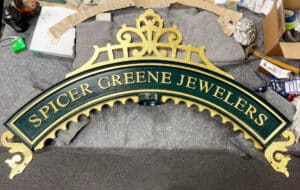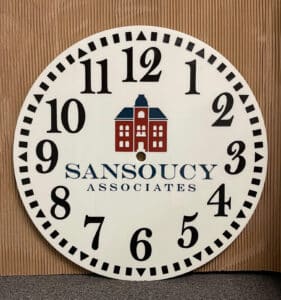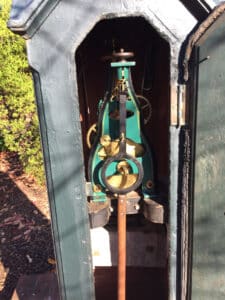By Eric Ryback, restorer and owner, Saint Louis Street Clock Company
“I never wore a watch. I always depend on public clocks, and stores have clocks, but that is strange.”
– Ben Katchor, American cartoonist and illustrator

Clock with a Seth Thomas No.2
auto-winder.
Street Clock Restoration
Everyone grows attuned to the passing of time in one way or another, whether it is the sun in the sky or the watch on their wrist, or the face of their phone. In the early 1870s, the awareness of time as people moved through their day was a service provided by the corner Post Clock (Street Clock). These four-faced cast iron clocks were typically owned by a nearby jeweler, bank, insurance company, railroad, or a government agency to draw attention to the time, and to the businesses that owned and maintained the Street Clock as a form of public service.
The History of Street Clocks
Vintage street clocks were made of all cast iron by craftsmen during the height of the industrial age. According to the Seth Thomas and E. Howard Clock Company records, the earliest street clocks were manufactured in the early-1870s. The clocks were located on the sidewalk in front of a business as a means of advertising that could be seen by those nearby and going by on horseback, trolley, and later by car.
By the end of the 1940s, the street clocks that survived had become known as the “Main Street Clock” in the heart of cities and towns across America. Over the decades many street clocks were hit and damaged by delivery trucks and automobiles as a result of being close to the curb. Therefore, vintage street clocks have become extremely rare. There is not an accurate estimate as to just how many street clocks have survived. The existing street clocks are usually owned by municipalities that had the foresight to save them, and some are in the hands of private collectors.
Street Clock Restoration: Iron, Glass, and Wood or Metal

sign ornament. Powder-coated, gold-leafed
with raised aluminum letters.
Iron: A complete restoration of a street clock starts with taking the clock down and apart. The cast-iron components made up the three outer components of the clock: the head, column, and base. Decades of layers of paint and rust are removed by sandblasting using steel grit.
Sandblasting the cast iron not only removes the paint and rust but also reveals any cracks and decorative pieces that may need to be replaced or welded back together. Any missing parts are recast in iron using patterns created from existing parts or a new pattern is created by making a casting of the original.
At this stage of restoration, the cast iron needs to be primed before being painted with either a two-part epoxy paint or a powder coating. After painting or powder coating, all the steel bolts and screws are replaced with stainless steel, and the bolt holes are re-drilled and tapped.

Brown Street Clock
Glass: The next step in the restoration is making new dials if the existing ones cannot be salvaged (which is more often the case). Dials were often replaced with white plexiglass or clear glass backed with white vinyl. Original dials were made of frosted glass and the backs were painted white. Numerals and letters were hand-painted on the face. Beginning in 1906 a pigmented structural glass was manufactured by Marietta Manufacturing Company (1890-1925). The Company originally made glass building materials, lamp chimneys, and was located in Redkey, Indiana from 1890 to 1903 before moving to Indianapolis where it stayed until the company was dissolved in 1981. According to one of its advertisements, Marietta Glass Manufacturing Company was also known for its milk-white “Opal” rough-rolled glass in “fancy patterns.”
A short time later, Libby–Owens-Ford Glass Company (est. 1898 as the Edward Ford Plate Glass Company) began production of their own version of structural glass called Vitrolite. Described in a company catalog as “colorful, structural glass for storefronts and residential use,” the glass was designed for a variety of uses in the kitchen and bathroom.
Vitrolite had ribbing on the backside of the glass which helped defuse light when backlit. Quickly, clock companies began using Vitrolite as a substitute for frosted glass. The Vitrolite Glass was 5/16” thick. The clock face numerals and letters were first carved into the surface of the glass and then painted.
At the very outside of the face of the clock was an outer protective glass. Because it was in front of the dials, this part of the street clock is typically highly weather-worn. It was replaced with a low iron glass fitted into the bezels sealed with silicon. According to dillmeierglass.com, “Float glass manufacturers create low-iron glass, also known as extra-clear glass or optically clear glass, by reducing the amount of iron in the molten glass formula. This type is more transparent than regular glass and doesn’t have that greenish tint. In fact, modifying the iron content can increase the light transparency by 5 to 6 percent. Low-iron glass also increases the flow of natural light, for added, seamless continuity between spaces.”

Wood or Metal: The hands used for E. Howard street clocks were made of western red cedar and the hands on the Seth Thomas street clocks hands were metal. Since the hands are protected by the outer clear glass, they generally are found in decent shape and require only to be stripped of old paint and repainted. The brass motion works located behind the dials in the head of the clock are taken apart and cleaned in an ultrasonic cleaner. Worn gears or pinions are replaced then re-assembled and oiled.
Timely Mechanical Movements
The earliest street clocks used weight-driven mechanical movements located in the basement of the business that owned them. Drive rods ran under the sidewalk directly under the base of the street clock then ran up through the base and column to the motion works in the head to turn the hands. It wasn’t long before the mechanical movements were re-located inside the base of the street clocks. On one of the four sides of the square base was an access door. The movement was mounted on a seat board, which provided easy access to wind the clock and adjust the time as needed. The weight, made of cast iron or lead, weighed between 108 to 160 pounds. It was compounded by a set of pulleys for easy winding every eight days. As the years passed, clock winders became scarce and unreliable. Owners would forget to wind the clock and people would notice.
Many movements were converted to electricity by removing the winding drum, unnecessary gears, pendulum, bob, and weights (sadly removing the unique mechanical engineering) and attaching a small electric synchronous motor to the frame. Seth Thomas made an electric auto-winder for their street clocks as an alternative to using a synchronous motor. By installing the auto-winder, the original movement could be left intact by just adding a gear motor to lift the weights. Today the synchronous motors are being replaced with electric motors installed directly behind the dials and operated by a controller in the base where the mechanical movement would have been.



with ’00’ time movement
100 More Years
A completed restoration of one of these 114+-year-old clocks brings out the beautiful details of the casting that were covered by layers of paint and rust. Replacing the plexiglass dials with carved Vitrolite dials backlit with new LED light rings adds a warm glow at night. Restoring a vintage street clock back to its original state is a labor-intensive process that requires patience, creativity, and time. The satisfaction of a completely restored clock is knowing you gave it another 100 years of public enjoyment!
I have been collecting and restoring rare and magnificent public timepieces for over a decade. My first restoration was a 1908 E. Howard two dial with a banner top. The clock ended up in my front yard and to this day it continues to amaze all who walk past it.
– Eric Ryback
St. Louis Street Clock Company started from a collector’s passion for these magnificent public timekeepers. It specializes in the Restoration and Reproduction of E. Howard & Co., Seth Thomas, Joseph Mayer, Ansonia, and Brown Street Clocks. The company also occasionally offers street clocks for sale, all of which have extensive historical provenance. The clocks are also rented out as props for productions – anything from Movie Studios, TV, Film, Documentaries, production crews, to plays, etc.
For more information, please contact Eric Ryback at 314-651-1051 and visit www.stlstreetclock.com
For additional resources, please visit the Journal of Antiques The Great Exchange Marketplace





Related posts: